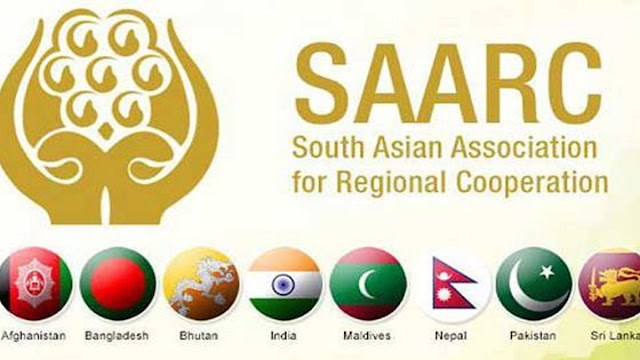Fruitless success of SAARC among the South Asian region
In the last quarter of the 20th century, regionalism saw a significant global shift. The overarching objective was to improve regional peace and prosperity through multilateral engagement.
The concept of nations that are close to one another but far apart geographically working together toward mutually agreed-upon goals is referred to as "regionalism."
The South Asian Association for Regional Cooperation (SAARC) was established in 1985 with the objectives of integrating the countries of South Asia, enhancing population well-being, and bringing about economic, social, and cultural development in the region.
Sadly, regionalism in South Asia, one of the world's poorest and least integrated regions, remains a pipe dream despite its formation four decades ago.
One of the many things that are becoming a hindrance in the pursuit of the SAARC's larger goals and objectives is the attitude of the SAARC states, which demonstrates their nationalistic tendencies. After the two world wars ended, even Europe's most patriotic and nationalistic nations started talking about working together.
Even though regional organizations like the European Union (EU) and the Association of Southeast Asian Nations (ASEAN) have integrated states that include even former adversaries, this strategy has not worked in South Asia.
This is primarily because Hindus, Muslims, and Buddhists from SAARC countries do not adhere to the same religion. The cultural, religious, and ideological landscapes of South Asia are intricate. The countries that makeup SAARC are reluctant to give up their identities because they do not believe that they are a part of a single region.
The terms "The Europeans" and "The ASEAN" are frequently used interchangeably within successful regional organizations like the EU and ASEAN. However, the SAARC nations do not own their organization because it is extremely unlikely that people from India and Pakistan will ever identify as SAARCIANs.
Consequently, the lack of identity is the root cause of SAARC's failure. SAARC has also been harmed by tensions between India and Pakistan, particularly over the disputed territory of Kashmir. There are numerous security issues, arms races, energy shortages, and water disputes between India and Pakistan.
The fact that these bilateral issues have delayed SAARC summits is a significant setback. For instance, in 2016, a summit was planned for Pakistan; Afghanistan, Bangladesh, Bhutan, and Nepal, on the other hand, were unable to attend due to India's influence and boycott.
SAARC will not be successful until India-Pakistan relations improve. Ironically, Article 10 prohibits bilateral and contentious issues from being discussed at the SAARC forum.
The inclusion of bilateral issues in the SAARC charter would allow other members to collaborate and exert pressure on India, which is why India opposes it. The lack of a mechanism for resolving conflicts and the persistence of rivalries impede the SAARC's progress.
Additionally, India's hegemonic ambitions impede South Asian cooperation. India and its SAARC neighbors have a significant power and resource gap, which contributes to a greater sense of unease among the SAARC states.
In his book "The Tragedy of Great Power Politics," Mearsheimer argues that in an anarchic international environment, great powers maximize their power until they achieve hegemony. Because it is a powerful state in South Asia, India tries to get SAARC member states to support Indian national interests.
It considers itself to be the region's dominant force; However, this viewpoint is not shared by the other SAARC nations. In addition, India is supporting sub-regionalism in South Asia to excludeunderminerom the region and undermining the significance of SAARC.
To maintain its dominance, it is leaving SAARC and joining other organizations like the Bay of Bengal Initiative for Multi-Sectoral Technical and Economic Cooperation (BIMSTEC). Bangladesh, Bhutan, Nepal, and Sri Lanka are all included, but Pakistan is not. India prefers to make decisions that are in line with its national interests, so it disregards the reservations and concerns of other states that are adjacent to it.
Indian policy aims to either dominate the smaller SAARC countries or break them up into smaller groups. These two goals prevent SAARC nations from working together. When confronted with issues that require collective resolution, the countries that make up the SAARC tend to focus on politics and their vested interests.
South Asia has enormous economic potential, but SAARC nations have not taken advantage of it. Both the South Asia Free Trade Agreement (SAFTA) and the SAARC Preferential Trading Arrangement (SAPTA) were realized; On the other hand, none of its members have made significant trades.
Under 5% of SAARC members trade within the region at the moment; less than any other local organization. The fact that trade between China and the United States is at its highest level, despite disagreements and differences, should be noted by states.
If South Asian nations can trade, they can normalize their trade relations, which will ultimately reduce tension and encourage cooperation in other areas. The environmental crisis in South Asia is also a major concern for nations because of its high vulnerability to climate change.
India and Pakistan are also affected by smog; The glaciers in Bhutan, Pakistan, and the Maldives are all melting. A collaborative approach is also required because of the youth bulge, child labor, overpopulation, gender inequality, and low literacy rate in South Asia.
Collaboration in these areas would undoubtedly resolve additional bilateral issues. States must learn from the EU and ASEAN to construct a common identity. Any attempt to create regional integration will fail if this identity is not nurtured.
Regionalism is impossible unless conflicts between the two nations are resolved. As a result, India must immediately stop considering itself South Asia's hegemon; and nations in the SAARC region need to stop being mean to one another, mend old wounds, and work together to make the future better.





No comments